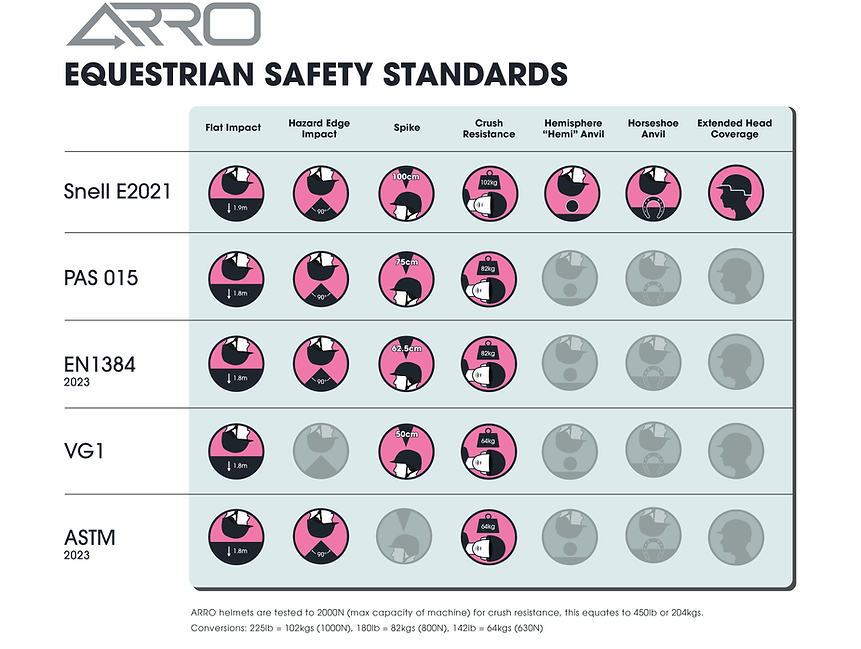SAFETY
We back up our safety claims with actual data/test results, our results are awesome and we are proud of our work as fellow horse riders.
To our knowledge we are the only equestrian helmet company that publishes their test results/ data. Why do you think other manufacturers would keep their results hidden...? You can answer this one for yourselves, or ask them!


Notes:
Temperatures: cold = -20deg C or -4 deg F, hot = 50 deg C or 122 F, ambient is room temp. Headform weight is 4.692 kgs (10.34 lbs) & 4.054kgs.
HPI: IJ36 and IE36
PAS 015, European (VG1 & EN1384) and ASTM performs basic testing only and does not test for horse shoe, round object (hemi) object testing. These additional testing requirements are part of the higher Snell standard only. Results from Snell in adapted format to ease of reading and copyright.
How do we compare? Crush protection alone
The highest crush protection available is very important, this is also where fatalities can occur. At ARRO we believe we have the highest in the world from all the helmets tested. Unfortunately, most equestrian helmets offer very little protection of only around 63-85kgs.
Notes:
Source: independent third party certified lab testing, not in-house etc to avoid any bias. Force measured when helmet deflection reaches 30mm.
Lateral crush is officially measured in Newtons (N). However, have converted to kgs and pounds for illustration and learning purposes. This is because most people (including some officials) don't realise that 630N only equates to 64kgs or 142lbs which is far too low for horse riding in our opinion.
The four main Safety Standards
Not all equestrian helmets are created equal; in fact, many fall significantly short of the protection needed for horse riding, amounting to little more than embellished, inexpensive bicycle helmets with some sparkle. Unlike most standards, only one rigorously tests against specific equestrian hazards, such as the impact of a horse's hoof or round objects like jumps, fences, posts, trees, and rocks. These round objects, common in equestrian environments, represent significant risks due to the concentrated impact point they create during a fall. The reality is, if you ride frequently, a fall is almost inevitable.
Equestrian helmets serve as essential safety equipment, not mere fashion statements. The stakes in equestrian sports are high, with falls and head injuries posing serious risks. A high-quality helmet can mean the difference between a minor incident and a catastrophic injury. This is where the SNELL safety standard, the highest in helmet safety, becomes critical.
The Snell standard is not about providing "extreme" protection; that notion is impractical as helmets are rarely tested for impacts from the height of a mounted rider or at speeds beyond a slow canter. Instead, the Snell standard offers superior protection by testing against a variety of impact scenarios. The nature of the surface you fall on greatly affects the outcome. While a fall in a soft sand arena might be forgiving, an encounter with a fence, gate, or tree involves concentrated forces, making the fall significantly more dangerous.
Our testing demonstrates that even some of the most popular and expensive helmets can transmit forces over 400g forces to the head from a fall onto a rounded object from just 1.8 meters. Such forces can lead to severe injury or even death. Given the inherent risks of equestrian sports, opting for a helmet without this level of protection is a gamble we cannot justify, especially with our knowledge as riders who have witnessed the consequences of serious falls
The FEI's recommendation in December 2023 for additional rotational tests to reduce the risk of concussions is a step in the right direction. These tests, harder to pass than MIPS testing (we estimate over 80% of helmets cannot pass this), aim to simulate more accurately the conditions of a fall from horseback rather than the height standing beside the horse (2.2m vs. 1.8-1.9m). Preliminary tests we've conducted have shown promising results at 2.2m (FEI recommendation). We actually went a bit crazy and cranked it up to 3.4m (8m/s) and still passed them.
We can't guarantee no injuries and/or death, nobody can as we don't control the falls and horses can have a mind of their own. However, we have done our very best to protect you (or your loved ones) and keep you enjoying the sport you love.
.png)
.png)
.png)
MIPS System
The primary goal of MIPS is to provide additional protection against rotational forces that can occur during a fall or impact. These rotational forces can lead to traumatic brain injuries or concussions.
Note MIPS only forms a part of the overall safety. MIPS only works on certain oblique falls and the reduction is only around 15%. However, if you fall straight (linear) into a horse jump/tree/fence etc then chances are MIPS won't make any difference so back to the helmet/standard itself.
We include a rotational system because it may help with certain falls, why not, if it may help then every company should if they are serious about safety. We believe that everything helps as sum of all parts, there are so many different falls. We educate riders that just can't have MIPS to keep you safe, its just part of the overall safety of the helmet.